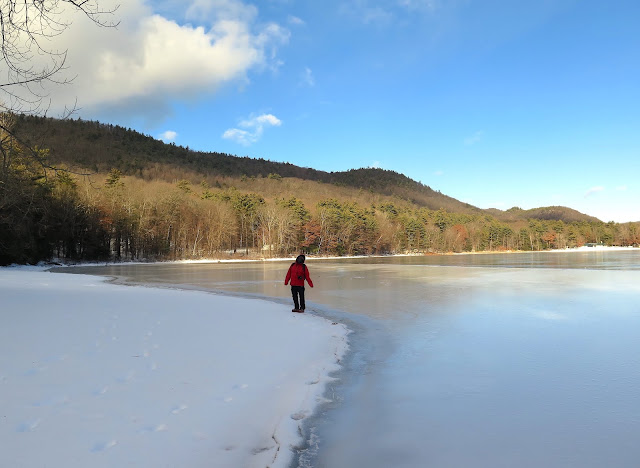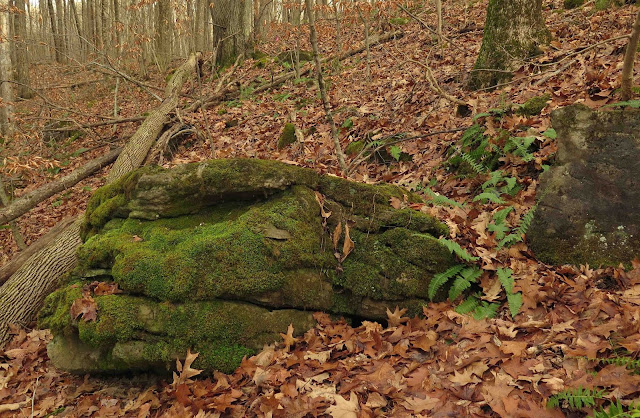Oh look! There was ice on the lake today!
Ah, but it was just a thin sheet of it, on the back bay of Moreau Lake. The rest of the lake still lay wide open, under a cloudless blue sky this Tuesday, with a bright sun warming the growing expanse of sandy shore at the north end of the lake. Every time I've visited the lake this last month, I've found the water receded yet more, from where it nearly reached into the woods at the beginning of this past summer.

Because Moreau Lake is a kettle lake, with no significant inlet or outlet, the water level fluctuates considerably, depending on rainfall and snowmelt. But the rapid changes in water levels over the last few years are quite puzzling, and are being investigated by hydrologists from the US Geological Survey. One of the possible causes under investigation might be the expansive development of housing in the adjacent area, where residential wells could be drawing down the water table that underlies the lake. To date, no conclusive evidence has been found to explain these puzzling changes in the lake's water levels.
It seems odd that we've had so little wintry weather so far this December, although forecasts predict we will have much colder weather starting tomorrow, perhaps even with some snow. This milder weather has made for easy woods-walking, anyway, and I have been wandering some of our nature preserves close to home this early winter, enjoying what natural pleasures are still to be found this otherwise un-eventful, in-between time of year.
December 1, The Skidmore Woods, Saratoga Springs
The many limestone boulders that litter this forest floor are home to much of the only greenery still to be found in December, namely, the mosses, lichens, and liverworts, as well as some evergreen ferns.
I'm not sure of which species of mosses cover the boulder pictured above (
Anomodon attenuatus could be one of them), but I do recognize the unusual fern that has made its home among them. It's called Walking Fern (
Asplenium rhizophyllum), because of the way its elongated fronds "walk" across the calcareous surface, establishing new plants wherever the tips of its fronds touch down on the moss-covered rock.
Other boulders here offer a home to some lush green Broom Moss (Dicranum scoparium), as well as a patch of some pink-rimmed, trumpet-shaped Cladonia lichen.
A thick patch of this very lacy-looking Delicate Fern Moss (
Thuidium delicatulum) has crowned a rock that is also home to a close-growing, dark-colored moss I don't recognize.
What looks like a fluffy green moss covering one side of this limestone rock is actually not a moss, but rather a liverwort called
Porella.
It's easy to see how this flower-shaped moss acquired the name Rose Moss. Its scientific name is
Rhodobryum ontariense, and it is usually found on calcareous substrates like the limestone rocks found all over the woods at Skidmore College.
Here's a little more "greenery" still to be found in a winter woods, only this is a fungus instead of a plant, and as its name, Blue-stain Fungus (
Chlorociboria aeruginascens), indicates, its color is just as much blue as it is green.
December 3, Lake Lonely Trail, Saratoga SpringsIt was late in the day when I visited this short trail that leads from a busy Union Avenue to the shore of the quiet Lake Lonely. A low sun cast long shadows across this wooden bridge that spans a creek.
The very dimness of the afternoon had me seeking the brightest spots of color I could find, and this thicket of Red Osier Dogwood (
Cornus sericea) certainly fit that distinction.
So did the dangling male catkins of a Speckled Alder tree (
Alnus incana).
I doubt there are any redder berries than those of the Winterberry shrubs (
Ilex verticillata) that thrive in the swamp that lines both sides of this trail.
You would have to look hard (and brave some sharp thorns) to detect the small red winter bud of a Prickly Ash (
Zanthoxylum americanum), one of the many different native shrubs to be found in the wetlands that surround the Lake Lonely Trail. Both the compound leaves and the petal-less flowers emerge from this single small bud.
December 6 and 7, Moreau Lake State ParkThe day was cold and the wind was brisk when I took a short walk along the shore of Moreau Lake one afternoon. A pair of ducks came winging in to rest on the wind-riffled water.
I'd neglected to wear a scarf to cover my ears, so I didn't walk long on this frigid day. A bright sun didn't add much warmth, but it did light up the empty flower bracts on this American Witch Hazel shrub (
Hamamelis virginiana), so it looked as if the twigs were blooming with small yellow flowers.
It was still quite cold the next day, when I returned to Moreau Lake State Park to walk the Red Oak Ridge Trail with my friend Sue Pierce. But we stayed in the woods, where we remained sheltered from the wind during most of our visit.
We didn't always stick to the trail, but we wandered up and down ravines and searched along rocky ledges, seeking to find plants that stay green all winter. I was delighted to find three of our winter-green native ferns all growing in close proximity, so I could include all three in a single photo. At the top is Christmas Fern (
Polystichum acrostichoides), with its individual leaflets shaped like tiny Christmas stockings; winging out from the middle are the arching fronds of Marginal Wood Fern (
Dryopteris marginalis); and dangling down toward the bottom are the lacy-looking fronds of Intermediate Wood Fern (
Dropteris intermedia).
We also found numerous Dissected Grape Ferns (
Botrychium dissectum) protruding from the leaf litter, some still as green as in summer, others either partially or completely purple. I believe this is our only winter-green grape fern.
We found several different species of evergreen clubmosses throughout the woods, but this curving cluster of Fan Clubmoss (
Diphasiastrum digitatum) was especially photogenic.
Many of our summer-flowering plants have evergreen leaves, and as we wandered around the forest, we found so many of their leaves still intact, we decided we needed to return in summer to find them all in bloom. This red-stemmed Striped Wintergreen (
Chimaphila maculata) looked quite pretty, snuggled up against the roots of a Yellow Birch.
The bright-green leaves of Pipsissewa (
Chimaphila umbellata) looked as fresh as they had last summer.
Both Sue and I were quite sure these round green leaves belonged to a species of Pyrola, most likely the Greenish-flowered Pyrola (
Pyrola chlorantha), since they didn't seem shiny or large enough to be those of American Pyrola (P. americana).
We had no trouble at all identifying these beautifully patterned curvaceous leaves as those belonging to Downy Rattlesnake Plantain (Goodyera pubescens), since none of our other species of Goodyera display such a distinctively white stripe along the leaf's midvein.
That ID was confirmed when we found a well-preserved flower stalk ascending from a rosette of Goodyera pubescens leaves. The Downy Rattlesnake Plantain bears a spike of small white flowers, and it is one of 15 species of native orchids that can be found in Moreau Lake State Park.
December 10, Bog Meadow Brook Nature Trail, Saratoga Springs
As I walked along the familiar wooded trail of this nature preserve near my home, I was startled to see that what I had always known as a wooded swamp was now an ice-covered pond, and it appeared to be close to encroaching upon the trail.
It was odd to see the spiky winter-shoots of Skunk Cabbage (
Symplocarpus foetidus) -- not normally an emergent aquatic species -- protruding above the thin ice that now covered this flooded wetland. Where has all this water come from? We haven't had that much rain.
Aha! Mystery solved! Beavers have dammed the normally small stream that flows through this swamp, which of course has caused the water behind the dam to accumulate and spread out into a pond. I suppose the trail stewards will have to dismantle this dam before the trail becomes impassable to hikers.
Other parts of this wooded wetland remained unchanged, with fallen logs covered with emerald-green mosses that seemed to glow in the dim light of the woods.
A closer look at those logs revealed a marvelous mix of different mosses, including this tight carpet of velvety Broom Moss (
Dicranum scoparium [or
fulvum?]) punctuated with individual plumes of Brocade Moss (
Hypnum imponens).
This section of rotting log was ornamented with quite a varied mix of organisms: a gray cluster of spent puffball fungus, the thready reddish webs of
Nowellia curvifolia liverwort, the flat-leaved shiny green liverwort called
Lophocolea heterophylla, and what looks to be the beginning of a population of Delicate Fern Moss (
Thuidium delicatulum). All of these organisms play a role in returning this rotting log's elements to the soil.
At least five different species of Horsetail Rush (
Equisetum spp.) inhabit this wooded wetland, but the only one I can reliably find this time of year is the miniature Dwarf Horsetail (
E. scirpoides) with its tangled masses of wiry evergreen stems.
What a pretty sight to end my early-winter walk at Bog Meadow: a lovely cluster of pinky-purple Foamflower leaves (
Tiarella cordifolia) resting atop a carpet of emerald-green Delicate Fern Moss.
















































